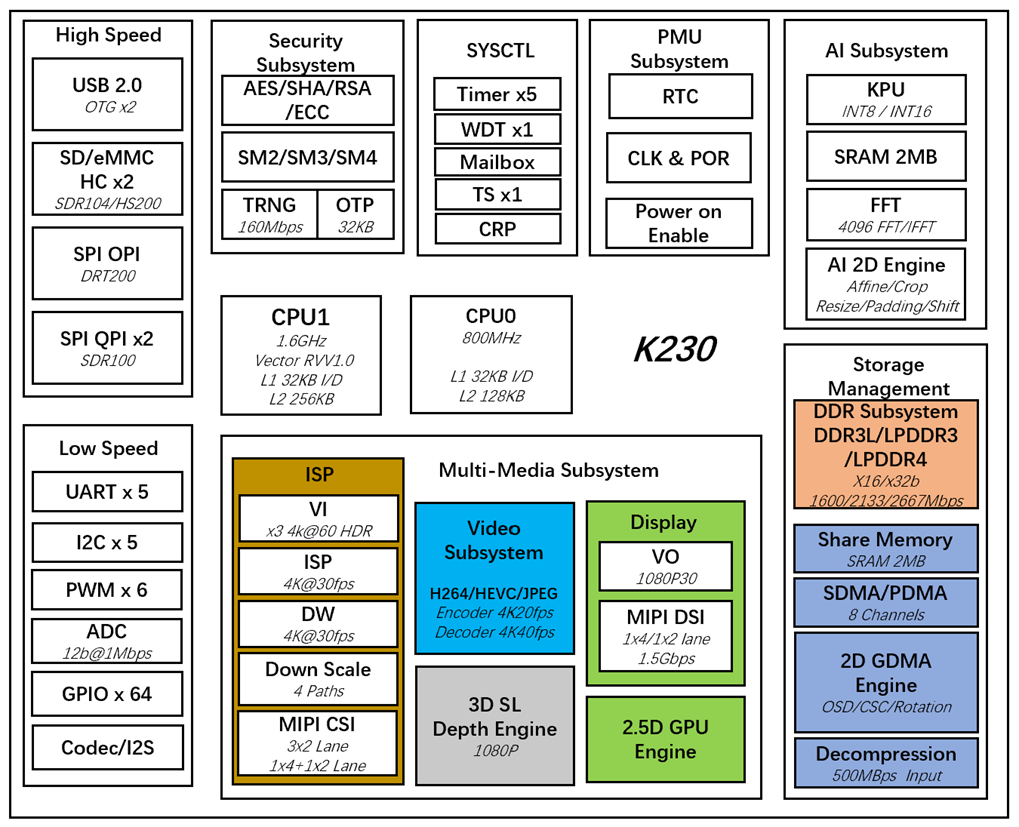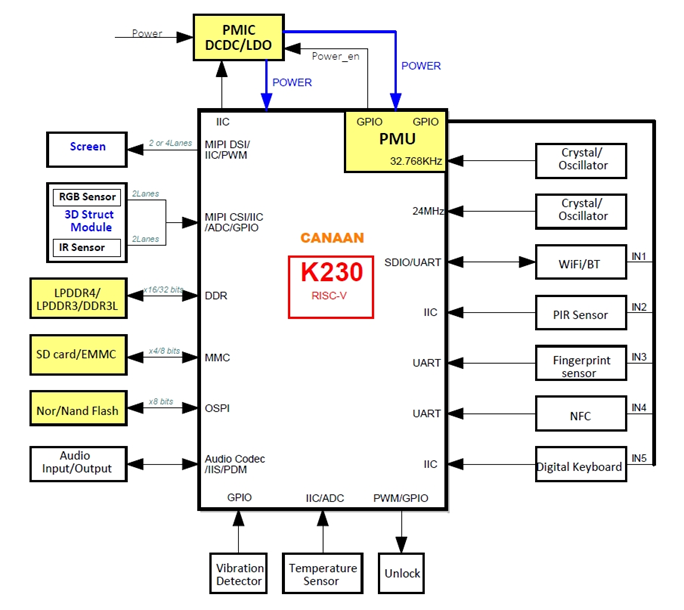K230 Product Brief#
Preface#
Purpose#
This document is intended to provide a general overview of the K230 platform and its features.
Intended Audience#
The main people to whom this document (this guide) applies:
Design and maintenance personnel for electronic products
Sales personnel for electronic products
Technical support personnel
Terms#
Revision history#
Version Number |
Author |
Revision Date |
Revision Notes |
|---|---|---|---|
V1.0 |
Zhenming Huang |
2023-6-10 |
Re-format to markdown document based on K230 Brief Datasheet_Complete_Apr_2023_v1 |
Overview#
The K230 chip is the latest generation SoC product in Canaan Technology’s (NASDAQ: CAN) Kendryte® series of AIOT chips. The chip adopts a brand-new multi-heterogeneous unit acceleration computing architecture, integrates two RISC-V C908 computing cores, and has a built-in new generation KPU (Knowledge Process Unit) intelligent computing unit. Multi-precision AI computing power with INT8 and INT16. Supports general AI computing framework. The chip also has a variety of peripheral interfaces, as well as multiple scalar, vector, graphics, and other dedicated hardware acceleration units such as image 2D engine, AI 2D engine, 2.5D GPU, and 3D depth engine. K230 provides full-process computing acceleration for various computing tasks such as images, videos, audio, AI, etc. The chip has many features such as low latency, high performance, low power consumption, fast startup, and high security. K230 can be used in various smart hardware products, such as smart door locks, home smart security cameras, dictionary pens, payment recognition, 3D structured light vision modules, drones, interactive robots, smart home appliances, smart toys, and smart manufacturing, intelligent vehicle cockpit and many other fields.
General Specifications#
CPU#
CPU 1: 64bit, RISC-V processor, 1.6GHz, supports RISC-V Vector Extension 1.0 specification, with floating-point units (FPUs), 128bits vector-process-unit, runs RTOS system
CPU 0: 64bit, RISC-V processor, 800MHz, supports RISC-V 64GCB instruction set, runs LINUX system
KPU#
Support INT8 and INT16
Support weight sparse compression
Typical network performance:
Resnet 50 ≥ 85fps @INT8
Mobilenet_v2 ≥ 670fps @INT8
YoloV5S ≥ 38fps @INT8
Support TVM / TensorFlow / Pytorch / ONNX
Support quantitative tool chain and profiling tools
Loss of quantization accuracy <1%
2D Engine#
2D(GDMA) Engine:
OSD/CSC/X-Mirror/Y-Mirror/Rotation(90/180/270)
Typical image rotation capability:
2 x 1080*1280 YUV400 @15fps + 1 x 1080*1920 YUV420 @30fps
Independent AI 2D Engine:
Affine/Crop/Resize/Padding/Shift
DPU (Depth Computing Unit)#
Using 3D structured light depth calculation
Support multiple operators, including Img_check / LCN / SAD / Post_proc / Align / Disptodepth
The maximum resolution of the landscape image is 1920*1080, and the maximum resolution of the portrait image is 1080*1440
Typical performance is 1280*800@30fps, 1280*1080@15fps,1920*1080@9fps
Memory#
DRAM: DDR3L / LPDDR4 with 16/32bit, LPDDR3 with 32bit
DRAM frequency:
DDR3L@1600Mbps / LPDDR3@2133Mbps
LPDDR4@2667Mbps
Maximum capacity: 2GB
SIP mode: 128MB 16bit LPDDR4@3200Mbps
SRAM:2MB+2MB (default for KPU)
Video Input#
3 x MIPI CSI
(1 x 4lane+1 x 2lane) or 3 x 2lane
ISP#
Total throughput:8MP@30fps
Image 3A / 2DNR / 3DNR / WDR / HDR
Local Tone Mapping
Sharpen / BLS / LSC / De-warping
RGB-IR 4x4 pattern
Video Output#
1 x MIPI DSI, 1 x 4 lane or 1 x 2 lane
Resolution: 2MP@60fps
Video Codec#
Video encoding
H.264 Baseline / Main Profile / High Profile
H.265 Main Profile
JPEG / MJPEG
Maximum encoding performance:
8MP@20fps
CBR / VBR / CQP / ROI encoding
Video decoding
H.264 Baseline, Main Profile, High Profile
H.265 Main Profile
JPEG / MJPEG
Maximum decoding performance:
8MP@40fps
2.5D GPU#
Highly optimized Tessellation Engine, cooperates with the VGlite driver to provide vector graphics drawing functions
Support rotation, scaling, translation, and format conversion of the input image
The drawn picture can perform operations such as blending, compression, etc., with the picture in video memory
Audio#
2 x DAC: 8-192Khz
2 x ADC: 8-192Khz
Support ALC
Maximum 8 x PDM DMIC inputs
I2S interface supports 2x2 expansion
Peripherals#
Low-speed interface
5 x UART / 5 x I2C / 6 x PWM
GPIO (multiplexed with function pins):
64 x GPIO + 8 x PMU GPIO
50 x GPIO + 6 x PMU GPIO(SIP)
High-speed interface
2 x USB 2.0 OTG
2 x SDxC: SD3.01, eMMC 5.0
3 x SPI: 1 x OSPI + 2 x QSPI
WDT / RTC / Timer
Security#
PUF / OTP / TRNG
Support AES, SHA, RSA, SM2/3/4, ECC
PMU#
Ultra-low power consumption: in deep sleep mode, standby power consumption ≤ 20uW
Support RTC function in 32KHz
Support long and short press detection as system shutdown or wakeup signal
Support IO edge and level detection to generate interrupts
Support two output IOs to control PMIC and system reset
Support 512 bits system log when shutdown
Other Features#
Decompression module:
decompression bandwidth ≥ 400MB/s, GZIP format
4096-point FFT / IFFT unit
Fastboot: 3A first picture ≤ 400ms
Working environment temperature: -40 ~ 85°C
Package:BGA, 0.65mm pitch
13 x 13mm
11 x 11mm (SIP 128MB 16bit LPDDR4)
Block Diagram#

Typical Applications#
3D Face Lock Integrated Application Solution

Smart Dictionary Pen Application Solution
